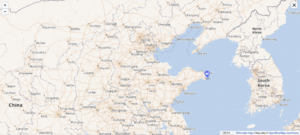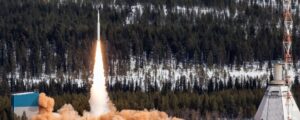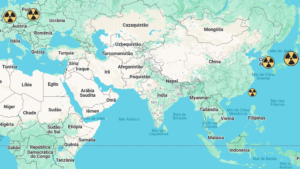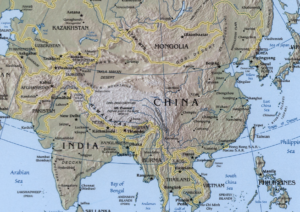- Space and its celestial bodies do not belong to anyone, but countries are responsible for what they do there.
- There is a new space race for the moon between the United States and China.
- The conquest of the moon has importance not only economically, but in symbolic terms of geopolitical competition.
More than 50 years ago, the first human being walked on the moon and, as he said, this was “a small step for man, a giant leap for humanity”.
This historic technological advance opened the way for man’s infinite possibilities in the cosmos.
However, given the real possibility of man exploring and using resources of the lunar soil, doubts begin to arise.
So does the moon and its raw materials have an owner?

Lunar Exploration History
On the Apollo 11 mission, crew members planted 6 American flags on lunar territory, but does this symbology give the United States any sovereignty over the moon?
Importantly, the missions between the 1950s and 1970s were just the first phase of a space race between the US and the Soviet Union. And if the Americans were the first to set foot on the moon in 1969, the Soviets were the first to put a satellite into orbit in 1957 and also the first to successfully land an aircraft on the moon in 1966.
However, only the United States sent manned missions to the moon, making a total of 6 aircraft. Meanwhile, the Soviet Union focused its efforts on sending unmanned missions that deployed robotic vehicular probes (rovers) and returned samples of lunar terrain to Earth.
With the rapid space conquests and focus, the concern about a possible military use of this unconquered galactic terrain became a concern of the United Nations (UN) and was placed on the agenda of the United Nations General Assembly (UNGA), the main deliberative body of the United Nations (UN) United Nations Organization.
International Agreements on Lunar Exploration
The first international resolution on lunar exploration was created in 1958. The Resolution, in short, recognizes that outer space is in the common interest of humanity and that the use of that space is peaceful.
The concept that a territory cannot belong to any State – despite claims – and that its use must be for peaceful purposes and to increase man’s knowledge to improve our existence, was enshrined in the Antarctic Treaty.
This treaty was adopted by the UN for the purpose of ensuring that Antarctica is used for international cooperation in scientific research and does not become a scene or object of international discord and possible armed conflict.
Therefore, the bases governing the common heritage of humanity are approved on the basis of the adoption of this treaty. However, the 1958 resolution has a recommendatory character and thus does not create obligations for States.
However, in 1967, the “Treaty on Principles Regulating the Space Activities of States in the Exploration and Use of Outer Space” was adopted, including the Moon and the other Celestial Bodies.
In this treaty, a collective regime for the use of cosmic space is imposed, and national appropriation by proclamation of sovereignty, by use or occupation, or by any other means is prohibited.
But the application of the concept of common heritage of humanity would only be recognized in 1979, with the adoption of the “Agreement that Regulates the Activities of States on the Moon and Other Celestial Bodies”. This agreement decrees that “the Moon and its natural resources are the common heritage of humanity”.
Although it cannot exercise sovereignty over outer space, it can be exploited by states. However, it must respect the interests of future generations.
Finally, despite the fact that outer space is considered a common heritage of humanity, this does not mean that States are not responsible for what happens there.
The 1963 declaration states that each State which launches an object into space and whose territory or base has been used to launch the object is internationally liable for damage caused by such object to another State or to its natural or legal entities, on Earth or in outer space.
The New Space Race for the Moon in the 21st Century
Between the 50s and 70s, the space race for the Moon between the United States and the then Soviet Union only became evident.
However, in the 21st century many countries have entered this new dispute and some of these countries have taken significant steps in the history of lunar exploration, bringing about a “new space race for the Moon”.
A good example is China, which evidently did not participate in the first dispute but in 2019 managed to land the Chang’e-4 probe on the Moon, which made a cotton seed sprout on the lunar surface for the first time in history and shared the objective. of structuring an on-site research base.
The country also sent rovers to the dark side of the moon known as the South Pole-Aitken Basin. The probe loaded instruments to analyze the geology of a previously unexplored lunar region and conduct biological experiments.
The Chinese also took a big step by successfully landing their first rover on Mars, becoming the second nation to do so after the US.
In view of this, the United States, which, after 6 visits to the Earth satellite, had stopped its missions to the Moon until then – as they considered it too expensive and without geopolitical and economic value in the 60s and 70s – now sees itself practically obliged to return to activity if they want to sustain their national pride in matters of outer space.
Top 8 New Missions to Explore the Moon in the 21st Century
Lunar missions scheduled or proposed by various nations — or organizations — serve as a guide to how the space race might develop over the next few decades, and some of the manned missions are:
The Dear Moon Project with the objective of space tourism, carried out by the US private company SpaceX.
- Project Artemis 2 with the objective of crew testing, carried out by the American space agency NASA, as a partnership between the USA and Canada.
- The Artemis 3 Project with the objective of putting the first woman and the next man to the Moon, carried out by the American NASA and planned for 2024.
- Project Orel for manned lunar flyby, carried out by Russia’s State Space Activities Corporation Roscosmos, planned for 2029.
The proposed manned lunar landing missions but still uncertain funding are:
- Project of the National Space Agency of China, called PSEL and proposed by the National Space Administration of China (AENC), for the 2030s.
- Project by the Japanese Aerospace Exploration Agency, still unnamed and proposed by the Japan Aerospace Exploration Agency (JAXA), for the 2030s.
- NASA project (USA), named Artemis (probably Artemis 4) around 2025.
- Project by Roscosmos (Russia), also called Orel so far and planned for the 2030s.
The future trend of lunar exploration and its geopolitical consequences
Mining on the Moon is a much-mentioned hypothesis among special researchers. With the metals being brought to Earth or taken to the Moon, where they could be used to build space stations or spacecraft components.
With current technology, there are already hypotheses that mining on the Moon can solve the Earth’s energy problem, since helium-3, abundant on the Moon and scarce on Earth, can be used as fuel in future nuclear fusion plants, but this would be a major engineering and logistical challenge, as well as very controversial.
But it’s not just the lunar natural resources that would be important. The symbolism that a space domain, in a way, can cause in the States is and will continue to be a fuel for this new space race that has gained more and more notoriety.
National pride and the need to prove which country has the most advanced technology will continue to drive future great achievements, even though we currently do not know what the long-term benefits of this space race will be, no state will relinquish such status.
The United States would certainly prefer to have the achievements for itself, in the first place, than to allow Russia or China, for example, to have them. If China forms a base on the Moon, it will be a great blow to American pride and nationalism and great symbolism for Beijing, and could even influence Earth’s geopolitical relations.
It is also important to emphasize the environmental factor that this new space race can cause. The lack of information on the subject is evident, but it will not take long for this topic to come to the fore, since the Moon is a natural terrestrial satellite that has a direct influence on our planet, so it is necessary to calculate how, in the extreme long term, exploration of the moon could influence the terrestrial environment.






























[…] are ideal for deep space research and satellite tracking. Therefore, countries participating in the new space race are potentially interested in this […]
[…] on factors such as: who could put the first manned spacecraft into orbit and who would be the first to walk on the Moon. It was also important for showing the world science, technology and the economic system of the […]